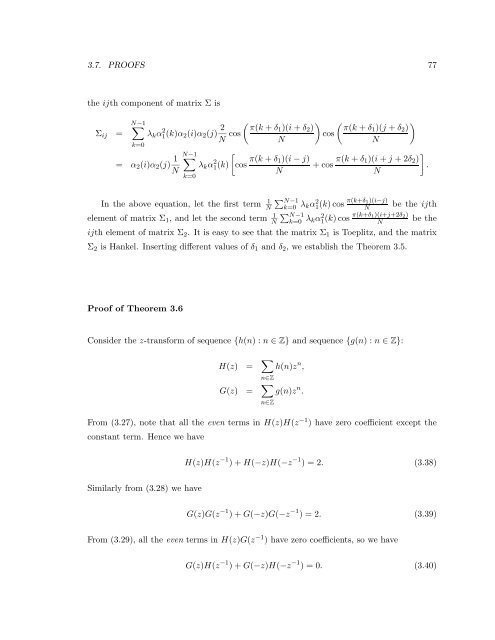sparse image representation via combined transforms - Convex ...
sparse image representation via combined transforms - Convex ...
sparse image representation via combined transforms - Convex ...
Create successful ePaper yourself
Turn your PDF publications into a flip-book with our unique Google optimized e-Paper software.
3.7. PROOFS 77<br />
the ijth component of matrix Σ is<br />
Σ ij =<br />
N−1<br />
∑<br />
k=0<br />
λ k α1(k)α 2 2 (i)α 2 (j) 2 ( )<br />
π(k +<br />
N cos δ1 )(i + δ 2 )<br />
cos<br />
N<br />
= α 2 (i)α 2 (j) 1 N<br />
N−1<br />
∑<br />
k=0<br />
( )<br />
π(k + δ1 )(j + δ 2 )<br />
[<br />
λ k α1(k)<br />
2 cos π(k + δ 1)(i − j)<br />
+cos π(k + δ ]<br />
1)(i + j +2δ 2 )<br />
.<br />
N<br />
N<br />
N<br />
∑ N−1<br />
In the above equation, let the first term 1 N k=0 λ kα1 2(k)cos π(k+δ 1)(i−j)<br />
N<br />
be the ijth<br />
element of matrix Σ 1 , and let the second term 1 ∑ N−1<br />
N k=0 λ kα1 2(k)cos π(k+δ 1)(i+j+2δ 2 )<br />
N<br />
be the<br />
ijth element of matrix Σ 2 . It is easy to see that the matrix Σ 1 is Toeplitz, and the matrix<br />
Σ 2 is Hankel. Inserting different values of δ 1 and δ 2 , we establish the Theorem 3.5.<br />
Proof of Theorem 3.6<br />
Consider the z-transform of sequence {h(n) :n ∈ Z} and sequence {g(n) :n ∈ Z}:<br />
H(z) = ∑ n∈Z<br />
h(n)z n ,<br />
G(z) = ∑ n∈Z<br />
g(n)z n .<br />
From (3.27), note that all the even terms in H(z)H(z −1 ) have zero coefficient except the<br />
constant term. Hence we have<br />
H(z)H(z −1 )+H(−z)H(−z −1 )=2. (3.38)<br />
Similarly from (3.28) we have<br />
G(z)G(z −1 )+G(−z)G(−z −1 )=2. (3.39)<br />
From (3.29), all the even terms in H(z)G(z −1 ) have zero coefficients, so we have<br />
G(z)H(z −1 )+G(−z)H(−z −1 )=0. (3.40)
















